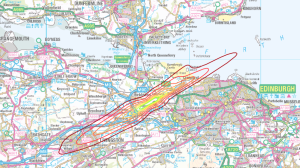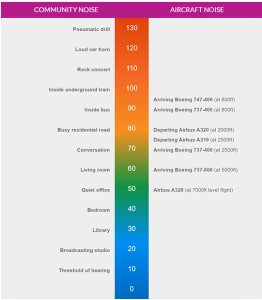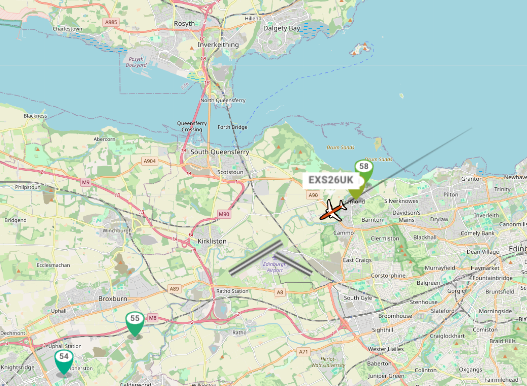Although aircraft noise cannot be completely eliminated, Edinburgh Airport works to understand and minimise community impact and are committed to explaining what you are hearing and why.
Aircraft Noise
The sound generated by an aircraft is affected by a range of factors. These include variations in the aircraft itself, engine type, size and loaded weight of the aircraft. There are also external factors such as changes in wind and weather conditions.
Noise from aircraft is measured in a variety of ways depending on what its end use will be. For contour mapping used in the airports insulation scheme noise is measured as an average over the summer time period, when noise is more frequent and communities have windows and doors open. This is called LAeq contour mapping. An example of this is shown below and more information is available on the Noise Lab website.


Lmax noise measurement
Noise is also measured as Lmax and this is the measurements you will see on the flight tracker and noise lab websites at the noise monitoring stations. Lmax is essentially the maximum noise of an individual aircraft as it passes over that location. This measurement is used for fining aircraft that exceed the maximum levels set to ensure noise is not excessive.

Aviation Noise
Aircraft noise originates from various sources, including engines, landing gear, and airframe components. The intensity of the noise depends on factors like aircraft type, flight altitude, weather and engine technology. While modern aircraft are significantly quieter than older models, noise can still be noticeable, especially during takeoff and landing.
Aviation Noise about Aviation Noise
Noise Lab
The Edinburgh Airport Casper Noise and Track System (NTK) is a state of the art monitoring system that is specifically designed as an intuitive system for noise and aircraft track analysis. Members of the public can access information from four fixed noise monitoring stations which are located in our communities and historic and live data on flights, aircraft and noise levels.
Noise Lab about Noise Lab
Noise Complaints
EAL compiles a quarterly report of all complaints received which is then reviewed by EANAB. Members of the public can submit a noise complaint directly through the Noise Lab Flight Tracker website or by emailing noise@edinburghairport.com
Noise complaints about Noise ComplaintsFAQs
Frequently Asked Questions relating to Noise
Noise measurements are used for various purposes, including:
- Assessing noise exposure: To determine the extent of noise exposure in different areas around the airport.
- Identifying noise hotspots: To pinpoint areas where noise levels are highest and may require mitigation measures.
- Evaluating noise abatement procedures: To assess the effectiveness of existing noise reduction procedures and identify areas for improvement.
- Informing community engagement: To provide transparent information to the public about noise levels and the actions being taken to address noise concerns.